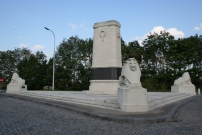| First Name: | Charles | Last Name: | KING | |
|---|---|---|---|---|
| Date of Death: | 10/07/1917 | Lived/Born In: | Queen's Park | |
| Rank: | Private | Unit: | Northamptonshire1 | |
| Memorial Site: | Nieuport Memorial, Belgium | |||
Current Information:Age-26 9, Caird Street, Queen's Park
The Battle of the Dunes The northern end of the Western Front was where it met the sea at Nieuport in Belgium. For most of the war this stretch of trenches was held by the Belgian Army but in the early summer of 1917 it was taken over by the British Army who hoped to launch an attack from there with the aim of pushing up the coast and capturing the main German submarine base of Brugges and its outlet to the sea at Zeebrugge. Code named Operation Hush, this was planned to coincide with the Passchendaele offensive further inland, which began at the end of July, 1917. But in the end it did not happen and one of the reasons why it was cancelled was the action taken by the Germans on 10th July, which became known as the Battle of the Dunes. The dividing line between the two sides here was the River Yser, except that the British held a bridgehead, about a mile in depth, on the northern side of this waterway where it met the sea and connected to the south side of the river by floating, wooden bridges. Aware that something was brewing on this stretch of the front, the enemy began shelling the area from 6th July. On 10th July this artillery bombardment became extremely heavy especially against these bridges, which were soon destroyed and against the bridgehead which was being held by 2nd King’s Royal Rifle Corps and 1st Northamptonshire of 2 Brigade, 1st Division. Communications were severed and the two battalions were soon isolated. The breast works protecting their shallow trenches were largely destroyed. To add to their problems a new type of gas shell containing Mustard gas (Yellow Cross) was used and German planes flew low, spraying the area with machine-gun fire. At 8pm the enemy infantry attacked on a 2000 yard frontage between Lombartzyde and the coast and within 20 minutes they had reached the river bank. Isolated parties of 2nd King’s Royal Rifle Corps and 1st Northamptonshire continued to fight but the two battalions had suffered 70-80% casualties and were in no state to put up a meaningful resistance. At 8.30pm, observers on the south bank of the Yser saw small parties still holding out around 1st Northamptonshire HQ and even the reserve company of 2nd King’s Royal Rifle Corps attempting a counter attack but they were soon overwhelmed. Later in the night three officers and fifty two men from 2nd King’s Royal Rifle Corps and eight men from 1st Northamptonshire swam back across the river. As a result of fighting on 10th July the bridgehead was lost and never recovered and many men became prisoners or casualties. Among the many casualties suffered by 1st Northamptonshire was Charles King. |
||||
| « Back to Search Results | ||||
| If you think any of the information shown here is incorrect, Click Here to submit your amends and comments | ||||




